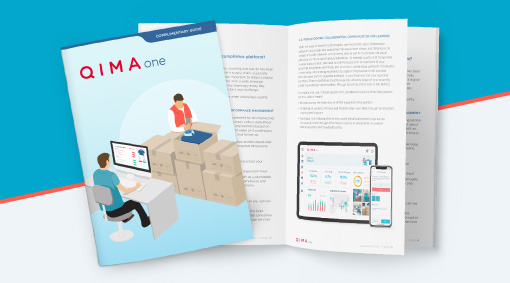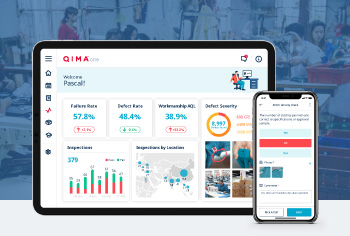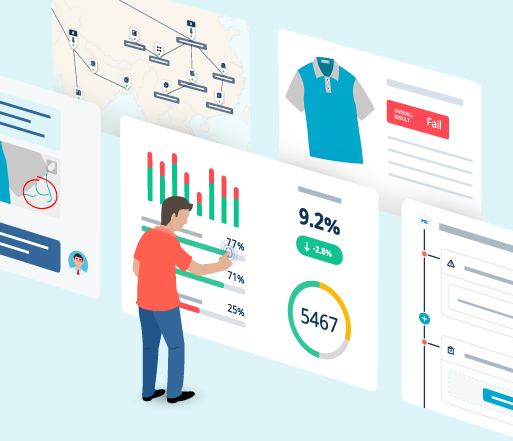
Article
Top 3 technology trends shaping apparel supply chains

Article
Top 3 technology trends shaping apparel supply chains
Article
Top 3 technology trends shaping apparel supply chains

Keep up-to-date with the latest supply chain insights.
“Many supply chains are perfectly suited to the needs that the business had 20 years ago.” Jonathan Byrnes, MIT Professor.
Apparel brands must digitize to survive in a world with ever-changing consumer demands, growing competitive pressures and increasingly complex supply networks. Every step in your supply chain from raw material sourcing to manufacturing and logistics has the potential to be digitized to ensure you meet your customer’s quality and social compliance standards.
Read on to uncover the most important technology trends shaping the apparel industry and what they mean for you.
- Supply chain mapping will enhance transparency and traceability
Today’s educated consumers expect brands to minimize their environmental and human impacts and will go as far as boycotting a brand that causes harm. Coupled with increasing compliance pressure from regulatory bodies, governments and civil initiatives, this is a trend that apparel brands cannot ignore.
As well as doing the right thing, there’s a financial plus-side for brands too – according to a study conducted by MIT, consumers are willing to pay up to 10% more for products if the business provides transparent information about the product and its origins.
If you’re an apparel retailer, it’s not enough to track just your direct Tier 1 suppliers who create the finished product. You should also look to collect data on your suppliers further down the supply chain such as your raw materials providers and mills to fully map your supply network.
However, according to QIMA survey data an average business knows less than 50% of their suppliers and 60% of executives have no knowledge of the items in their supply chain beyond Tier 1. Less than 25% of businesses use technology to map their supply chain beyond Tier 1, hinting that there’s some definite room for growth here.
Supply chain mapping technology helps you meet the demands of your customers. It provides much-needed visibility by enabling you to collect data on your direct and indirect suppliers such as factory location to help identify and prevent unauthorized subcontracting, and implement GPS tracking to pinpoint exactly where your products are produced.
- Automation to improve quality management
Like many industries, quality management is ripe for automation to increase accuracy, streamline processes and reduce costs, and it’s increasingly on the radar of industry leaders.
Many quality control tasks have traditionally been carried out manually but can now be automated thanks to technological advancements. Some examples include:
- Automated inspection report generation using photos and data inputted from the factory floor
- Automated inspection checklists to ensure consistency across quality checks
- Automated pre-shipment inspection approval to reduce time to market
- Automated self-inspection booking for low-risk, reliable suppliers or low-risk products
- Automated inspection allocation based on location, product expertise and team schedules
- Automated re-inspections if inconsistencies or defects are found in the quality inspection results
There are many opportunities for automation to enter the quality control process and we’re just starting to see the potential benefits and opportunities of this emerging trend.
- Digitization of supply chain operations
Digitization is a winning advantage in today’s ultra-competitive retail environment, especially when 65% of quality control leaders still rely heavily on outdated tools such as e-mails and spreadsheets to manage their QC function.
Moving away from pen and paper speeds up decision making, provides greater visibility, enables effective collaboration and empowers businesses to respond quicker to unexpected disruptions, shifts in consumer behavior or major global events.
Some examples of ways businesses are digitizing their supply chain processes include:
- Mobile apps to gather inspection data including measurements, defects and images that are shared instantly to quality managers for real-time monitoring
- RFID systems to capture and automatically report production data including factory down-time, line efficiency and quality information
- AI-powered models to forecast retail sales in a location or season and adjusting production and inventory accordingly
- Advanced data analytics to identify supply chain trends and alert factors such as under-performing suppliers or recurring quality issues, with the goal to ultimately prescribe corrective actions automatically.
Find 3 ways to empower your
suppliers with more data!
Get your guide today!

Find 3 ways to empower your
suppliers with more data!
Get your guide today!
What does this mean for apparel brands?
It’s a fact that today’s apparel supply networks are still largely siloed and relying on legacy systems and manual processes day-to-day. But the technology train is quickly re-shaping global supply chains and there are a multitude of benefits for brands who can jump on board – those who don’t may risk being left behind.
In the years to come, these technology trends will help brands to break down the walls of their siloes that are making their own internal operations much more difficult, as well as keeping customers in the dark as to where and how the products they buy are made.
To do so effectively, brands require reliable supply chain partners who understand the power of technology to transform the apparel industry. QIMAone can help you digitize your quality control with smart inspection software that enables collaboration with your suppliers, ensures consistent product quality, collects accurate data and provides end to end visibility over your network.
QIMAone is backed by 15 years of quality and compliance expertise, distilled into easy-to-understand tools and guidance, such as up-to-date inspection checklists for all product categories, best practice training tools and more.
Want to see QIMAone in action?
Learn more about our platform by scheduling a demo today.
Most Popular Articles
Corrective Action Plans 101: Your Basic Guide to Ensuring Supply Chain Quality Excellence
The Benefits of a Data-Driven Supply Chain
6 Benefits of Supply Chain Visibility
How to Implement a Quality Management System
Simpli Home: Ensuring product quality and compliance with supply chain technology
7 Effective Ways to Improve Your Quality Management System
Supply Chain Visibility: Complete Guide for Supply Chain Managers
Boost Quality Control with Supplier Performance Metrics





